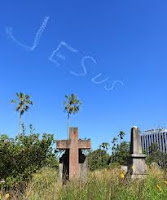When I was a kid in New York
I remember a lot of skywriting overhead. It was much more common then and
mainly at the seaside. A brief account follows -
In a 1926 letter to The
New York Times one Albert T. Reid wrote:
A newspaper paragraph says skywriting
was perfected in England in 1919 and used in the United States the next year. Art
Smith, who succeeded Beachey in flying exhibitions at the Panama-Pacific
Exposition in San Francisco in 1915, after the latter had been killed, did
skywriting, always ending his breathtaking stunts by writing "Good
night." This was not a trial exhibition but a part of every flight, and
was always witnessed by thousands.
Major Jack Savage, former
RAF pilot and writer for Flight
magazine, had a successful skywriting fleet of Royal Aircraft Factory S.E.5 aircraft
in England. He flew throughout the 1920s and 1930s, bringing the practice to
America as well. The first use of skywriting for advertising purposes was on
November 28, 1922 over New York City.
The typical smoke generator
consists of a pressurized container holding a low viscosity oil such as
Chevron/Texaco "Canopus 13" (formerly "Corvus Oil"). The
oil is injected into the hot exhaust manifold causing it to vaporize into a
huge amount of dense white smoke.
Wind and dispersal of the
smoke cause the writing to blur, usually within a few minutes. However special
"skytyping" techniques have been developed to write in the sky in a dot-matrix
fashion, and are legible for longer despite the inevitable blurring effect
caused by wind.
 Digital Skywriting, also known as dot matrix
skywriting and skytyping, digital skywriting is the process of using 5 planes
in formation and advanced computing to choreograph puffs of smoke being
released from each plane. When viewed from below messages can be seen very
clearly being written in the sky by the squadron of skywriters. These digitally
sky-written messages written at 10,000 ft can be up to 1250 ft tall and over 5
miles long. Digital skywriting allows planes to put any message into the sky in
any colour without having to do advanced and acrobatic flying manoeuvres.
Digital Skywriting, also known as dot matrix
skywriting and skytyping, digital skywriting is the process of using 5 planes
in formation and advanced computing to choreograph puffs of smoke being
released from each plane. When viewed from below messages can be seen very
clearly being written in the sky by the squadron of skywriters. These digitally
sky-written messages written at 10,000 ft can be up to 1250 ft tall and over 5
miles long. Digital skywriting allows planes to put any message into the sky in
any colour without having to do advanced and acrobatic flying manoeuvres.










No comments:
Post a Comment